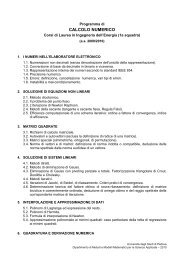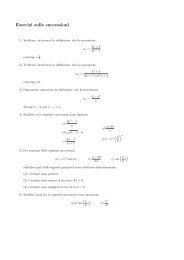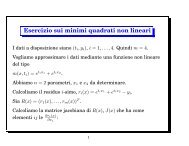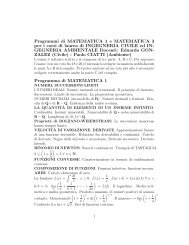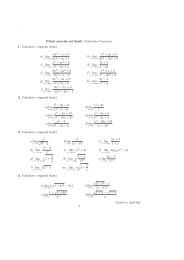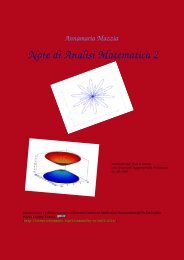You also want an ePaper? Increase the reach of your titles
YUMPU automatically turns print PDFs into web optimized ePapers that Google loves.
Altri esercizi sulle funzioni (Valentina Casarino)1. Risolvere graficamente le seguenti disequazioni:√4 − x2 > x + 2; x 2 ≥ |x − 1|;√1 − x2 < x.2. Data la funzione f(x) = x 3 − 1, disegnare i grafici dif(x), |f(x)|, f(|x|), −f(x), 2f(x), f(x + 1), f(2x), 3|f(x)| − 1.3. Si consideri la funzione f : (0, 3) −→ R definita da:⎧⎪⎨f(x) =⎪⎩x 2 se 0 < x < 12 se 1 ≤ x ≤ 232 (x − 3)2 se 2 < x < 3.Determinare l’immagine di f, f ((1/2, 5/2]), f −1 ([1, 3/2]) e f −1 (2).4. Sia data la funzione⎧⎪⎨6 − 3x se x > 2f(x) =⎪⎩ 6se 0 < x ≤ 1.xDeterminare l’immagine di f. Studiare l’iniettività di f e scrivere, se possibile, dominio, immagineed espressione della funzione inversa f −1 .5. Data la funzione⎧ √⎨ x − 1 se x ≥ 1f(x) =⎩x + c se x < 1,studiare l’iniettività di f al variare di c ∈ R. Quando esiste, scrivere dominio, immagine edespressione della funzione inversa f −1 .6. Date le funzioni f(x) = 1 − x 2 e g(x) = √ x, determinare dominio e immagine delle funzionicomposte g ◦ f e f ◦ g e scriverne le espressioni.7. Siano f : [1, 2] −→ [−1, 1], f(x) = 2x 2 − 4x + 1, e g : R −→ R definita da:⎧x + 2⎪⎨se x < −1g(x) = −x se −1 ≤ x ≤ 1⎪⎩x − 2 se x > 1.Determinare dominio, immagine ed espressioni di g ◦ f.
Valentina Casarino - FunzioniAltri esercizi sulle funzioni - Soluzioni1. (−2, 0); x ≤ −1−√ 52, x ≥ −1+√ 52;√22 < x ≤ 1.3. Im f = (0, 3 2 ) ∪ {2}; f ((1/2, 5/2]) = ( 1 4 , 3 2 ) ∪ {2}; f −1 ([1, 3/2]) = (2, 3 −f −1 ({2}) = [1, 2].4. f : (0, 1] ∪ (2, +∞) → (−∞, 0) ∪ [6, +∞) iniettiva;f −1 : (−∞, 0) ∪ [6, +∞) → (0, 1] ∪ (2, +∞);⎧⎪⎨f −1 (x) =⎪⎩6xse x ≥ 6− 1 x + 2 se x < 0.3√23 ];5. f iniettiva se c ≤ −1 e suriettiva se c ≥ −1.Se c ≤ −1, allora f : R → (−∞, 1 + c) ∪ [0, +∞),f −1 : (−∞, 1 + c) ∪ [0, +∞) → R e⎧⎨ 1 + x 2 se x ≥ 0f −1 (x) =⎩x − c se x < 1 + c.6. g ◦ f : [−1, 1] → [0, 1], (g ◦ f)(x) = √ 1 − x 2 ;f ◦ g : [0, +∞) → (−∞, 0], (f ◦ g)(x) = 1 − x, x ≥ 0.7. (g ◦ f)(x) = −(2x 2 − 4x + 1).



